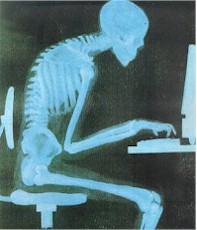In my last post, I introduced you to the human spine, and how dysfunction within the spine can affect sports performance - specifically the game of golf. I closed out my last post with a statement about back pain, and how the majority of it presents in the low back.
Today we talk about why that is.
There are numerous culprits when it comes to low back pain...trauma, vertebral degeneration, bulging and herniated discs...the list goes on and on. In this post however, we will discuss the issue of low back pain as a result of poor thoracic mobility.
Yep, that's right...poor mobility in your thoracic spine can actually cause your low back to hurt!
Before moving forward, let me say that if you have not read my previous post, The Aging Golfer, please read it first.
Now where were we? Oh yeah thoracic mobility...or lack thereof.
In my previous post I introduced you to the concept that each region of the spine is comprised of vertebrae that are built for a specific purpose. You also learned about the alternation of mobility and stability within the regions of the spine.
So...as a golfer, why are you experiencing low back pain?
One of the reasons could be due movement dysfunction in the thoracic spine. "What in the world does that mean?" you ask. Simply stated...you have lost mobility in your thoracic spine.
Your next question is probably "How does that happen?"
Remember my post on muscle imbalance? Much of what we do, creates an imbalance between the muscles on the front of our torso, or chest (anterior) and the muscles of our back (posterior). This anterior/posterior imbalance is often the result of chronic poor posture...what I like to call computer posture.
Many of us (including me) spend a great deal of time in front of a computer. Sitting in front of a computer does not promote the best posture. Many individuals look just like the picture below...
When in fact, we should look more like this...
An ergonomically correct computer workstation looks like this...
There is a great deal of truth to this picture...if you believe in the theory of evolution.
So let's get back to what happens here....
When we repetitively place our bodies into poor posture, our muscles begin to adapt. Remember the term adaptive shortening? This means that muscles that are frequently shortened, will adapt to that shortened length. Muscles that are put 'on stretch' or lengthened for long periods of time, will also adapt to that length. The body's response is to make those shortened and lengthened states, the new resting lengths of the affected muscles.
A good example of this concept is the muscles that control and stabilize the shoulder capsule...the chest (pectorals), anterior deltoids, and the back muscles (upper, mid, and lower trapezius, rhomboids, and posterior deltoids, and a few others. As we sit, hunched over the computer, the mid and upper back round (kyphosis), the shoulders roll forward (protract), and the head juts forward. Sitting in this position for hours, day after day, causes the muscles of the chest and anterior deltoids to adapt to this shortened position, and become overactive. On the back side, the antagonist muscles (remember that term?) which control the position of the shoulder blades, and the alignment of the spine, become lengthened, weakened, and underactive.
This has now become the new normal for you!
As a result, the muscles that stabilize and control the alignment of the thoracic spine become weak, and turned off...much like that of turning on and off lights in your house.
Soon these muscles become 'fixed' in their positions...and as a result, do not allow for proper movement within the thoracic spine.
What region of the spine is located just south of the thoracic spine? That's right! The lumbar spine. Is the lumbar spine supposed to provide mobility or stability? Right again! You guys are good! The lumbar spine is built for stability. One of it's primary jobs is to provide a stable base from which the thoracic spine can move.
So...if the thoracic spine is 'locked up' and unable to provide good quality movement, what do you think takes over? That's right...the lumbar spine...but wait! The lumbar spine is not designed to be highly mobile...that could be a problem.
Well...that's enough for one day. We'll finish this up in the next day or so.
Yours in Health and Performance
John





No comments:
Post a Comment